When does it make “cents” to stop outsourcing and build an in-house automated finishing system?
Good question. It starts with knowing how much you currently spend and how much throughput volume you may need in the future. How much do you spend now on outsourcing your part finishing?
Many manufacturers outsource some to all of their finishing, be it powder coating or liquid finishing, because they want to leave it up to “experts,” don’t have space for a system, and desire to concentrate on what they do best, like fabricating and assembling final products. They could also have unusual or rarely needed parts that simply cannot be done on their in-house systems.
Let’s just assume you are outsourcing your finishing because your need for it started out small but has grown over time. At this point, you mainly do it because, “It’s what we’ve always done.” Maybe it’s time to start working on a business case that would let you know if you’re ready for your own system!
Let’s also throw some hypothetical numbers at this issue.
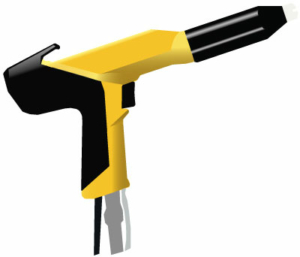 Imagine your outsourcing of finishing has grown over the years to about $1 million per year with local (or maybe distant) custom-coaters. How much money could an automated, in-house system save you per year that would justify the relatively large capital expenditure?
Imagine your outsourcing of finishing has grown over the years to about $1 million per year with local (or maybe distant) custom-coaters. How much money could an automated, in-house system save you per year that would justify the relatively large capital expenditure?
As a starting place, would it make sense that you would at least save the gross profit margin your custom-coaters are currently collecting from you? (For this article, we’ll ignore the fact that bringing finishing in-house is also likely to decrease total WIP, greatly decrease re-work, improve turn times, and save on transportation costs, too.)
Obviously, that gross margin varies depending on product, unique challenges, etc., but let’s sling a guess at it.
IntelliFinishing’s parent company (Kasa) operated a relatively large fabrication and coating company called KasaFab for many years before selling it to a local manufacturer.
Our former VP of that company still works for Kasa, and he said, “On small-quantity powder work, we would charge a pretty high margin of 60 to 65%. On large-quantity work, we would shoot for 50 to 55%.”
Now, maybe your custom coater doesn’t get as much margin as our former KasaFab operation. This might be because there are more competitors in your market. After all, KasaFab (now Vortex Fab) is the only large fabricator for at least 50 miles or more in any direction. It is in the middle of Kansas!
Meanwhile, I’ve also heard it said by longtime experts in the field that you should be able to save at least 20 to 40% by bringing coating in-house.
So, let’s start conservatively and imagine a savings of only 25% to represent the gross margin your custom coater is charging. This means a new automated system should save you at least $250,000 per year, assuming the previous assumption of $1 million per year being outsourced.
 Depending on the types of product you need coated, even a relatively traditional monorail could be paid for in about two to four years for this amount of savings. After that, it would be savings that go to your bottom-line profits. Most simple monorail systems likely cost between $500,000 and $2,000,000, but this is entirely dependent on process requirements for pre-finish steps such as shot-blasting, washing, and dry-off ovens, as well as for the type of booths and cure ovens and specific conveyor requirements for the part dimensions and weight considerations.
Depending on the types of product you need coated, even a relatively traditional monorail could be paid for in about two to four years for this amount of savings. After that, it would be savings that go to your bottom-line profits. Most simple monorail systems likely cost between $500,000 and $2,000,000, but this is entirely dependent on process requirements for pre-finish steps such as shot-blasting, washing, and dry-off ovens, as well as for the type of booths and cure ovens and specific conveyor requirements for the part dimensions and weight considerations.
However, for an IntelliFinishing System, it’s a little more complicated. Our systems are much more flexible than monorail systems in that we can accommodate processes for a much wider variation of parts. IntelliFinishing systems use a friction tube conveyor that allows for control of every section of track, so every carrier can, in effect, be given a different process recipe (video: www.intellifinishing.com/part-recipes).
We also have a sophisticated software control system to integrate each independently operated section of track to keep items moving as per the recipe, yet also keep carriers from bumping into each other. Consequently, the conveyor and controls are somewhat more expensive than monorail systems, but often highly competitive with power & free chain-based systems.
Therefore, most IntelliFinishing systems installed have cost between $1,500,000 and $10,000,000, with an average of about $3,000,000.
But, here’s the kicker! An IntelliFinishing System is usually way less expensive to operate. Here’s a link to an article we recently published that explains why this is the case.
Since any custom-coater you are likely to use is unlikely to have an IntelliFinishing System, any manufacturer who installs an IntelliFinishing system is very likely to save much more than just the gross margin.
If the IntelliFinishing technology makes sense for your company based on the parts needing finished or your volume, then the “$1 million outsourcer” example we have suggested could save up to 60% compared to outsourcing. Thus, $600,000 per year saved could finance a much more economical IntelliFinishing system very quickly!
Of course, there may be other considerations. Do you have space for a system? If so, great! If you’re unsure, talk to us. Our system often saves 25 to 40% in footprint depending on the nature of your parts and processes. If you need to build or lease a new space, you will obviously need to include those costs in your calculations, too.
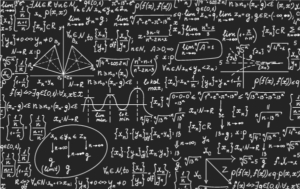 Ultimately, this is just a first-cut calculation to begin the process of considering a new finishing system. If your calculus indicates you might benefit from a system, the next step is to start finding a vendor to draft up a layout and determine a budgetary or formal quote.
Ultimately, this is just a first-cut calculation to begin the process of considering a new finishing system. If your calculus indicates you might benefit from a system, the next step is to start finding a vendor to draft up a layout and determine a budgetary or formal quote.
But, before you decide to go with any one system, I’d also like to suggest you figure out your likely actual costs of having and running a new finishing system. You should do this from the ground up. The costs would include system and building utilities, building lease or purchase costs, depreciation considerations, manpower to operate the system, possible restructuring of existing processes and flow, and, of course, paint or powder costs, maintenance, etc.
If you are ready to consider bringing finishing in-house and are wondering if an IntelliFinishing system might be a good fit for you, check out our website and watch a few of our videos, then contact us. We will be happy to help you not only figure out a potential system, but also to help you with your cost justifications.

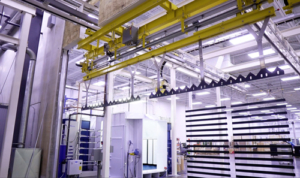 The MRI system features a 20-foot carrier and shuttle on the left-hand side of the system for transporting products from the load area, through an automatic and integrated sliding door into their unheated and uncooled added manufacturing space where automatic washing, dry-off and curing processes occur.
The MRI system features a 20-foot carrier and shuttle on the left-hand side of the system for transporting products from the load area, through an automatic and integrated sliding door into their unheated and uncooled added manufacturing space where automatic washing, dry-off and curing processes occur.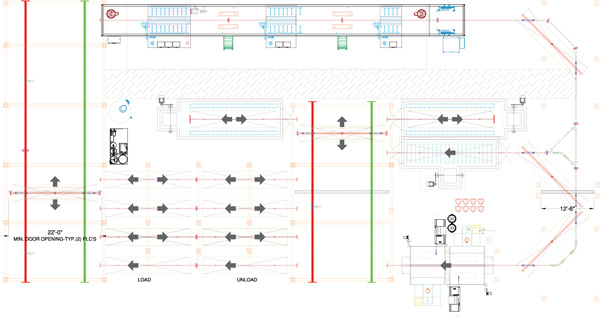 Not all of MRI’s parts require finishing. They also use the system to just wash and dry metal parts that will be unfinished in the final assembled monitors. This greatly improves the overall quality of their sets by removing unwanted dust and oils – a process they used to do by hand.
Not all of MRI’s parts require finishing. They also use the system to just wash and dry metal parts that will be unfinished in the final assembled monitors. This greatly improves the overall quality of their sets by removing unwanted dust and oils – a process they used to do by hand. 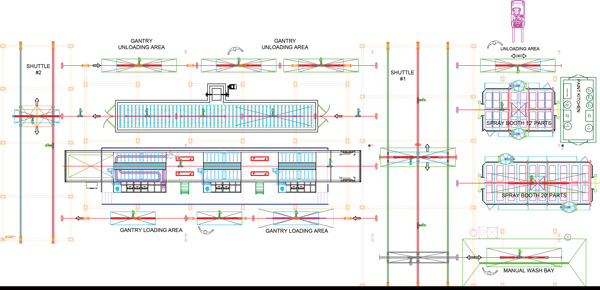 Depending on the size of the part, there are different flow paths through the system. This is caused because one of the two shuttles allows part only up to about half the size of the other shuttle. Since the majority of their parts are at or below 12-ft. in length, after being loaded in the loading lane, carriers proceed to the left onto a shuttle sized for up to 12-foot parts. This shuttle moves laterally from the loading lane to line up with the wash booth lane. From there the carrier can back up off the shuttle moving from left to right and go through a multi-stage automated wash booth lane. After wash, carriers flow onto a larger right side of the system shuttle and into one of their two liquid spray booths. After being coated, items back out of their respective booths and onto the larger shuttle again. The shuttle transports the parts laterally again up to the cure oven lane where they leave the shuttle and flow into the final cure oven. At this step, each carrier can have its own oven timing setting to maximize force cure quality, while eliminating chances of under or over curing products. Cure time is controlled by the system recipe selected at load per carrier. After curing, the carriers move once again to the first shuttle and laterally again up to the unload lane for final unload and the consequential return of the carrier via the large secondary shuttle back to the load area lane on the other side of the system.
Depending on the size of the part, there are different flow paths through the system. This is caused because one of the two shuttles allows part only up to about half the size of the other shuttle. Since the majority of their parts are at or below 12-ft. in length, after being loaded in the loading lane, carriers proceed to the left onto a shuttle sized for up to 12-foot parts. This shuttle moves laterally from the loading lane to line up with the wash booth lane. From there the carrier can back up off the shuttle moving from left to right and go through a multi-stage automated wash booth lane. After wash, carriers flow onto a larger right side of the system shuttle and into one of their two liquid spray booths. After being coated, items back out of their respective booths and onto the larger shuttle again. The shuttle transports the parts laterally again up to the cure oven lane where they leave the shuttle and flow into the final cure oven. At this step, each carrier can have its own oven timing setting to maximize force cure quality, while eliminating chances of under or over curing products. Cure time is controlled by the system recipe selected at load per carrier. After curing, the carriers move once again to the first shuttle and laterally again up to the unload lane for final unload and the consequential return of the carrier via the large secondary shuttle back to the load area lane on the other side of the system.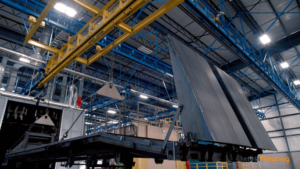 Load Trail had a significant challenge finishing its agricultural trailers. The trailers range in size from 24 to 53 feet in length and weigh up to 10,000 lbs. To help them solve the problem of powder coating these trailers and to streamline their finishing, we installed a
Load Trail had a significant challenge finishing its agricultural trailers. The trailers range in size from 24 to 53 feet in length and weigh up to 10,000 lbs. To help them solve the problem of powder coating these trailers and to streamline their finishing, we installed a 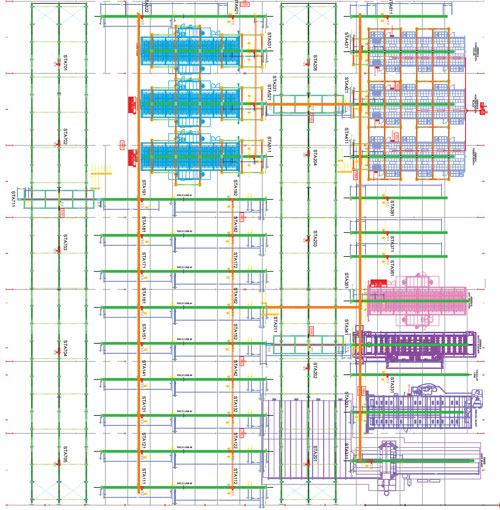 the shuttle, it allows for a massive system, but one that still saves space because it does not require any bulb turns or return sections of chain track.
the shuttle, it allows for a massive system, but one that still saves space because it does not require any bulb turns or return sections of chain track. 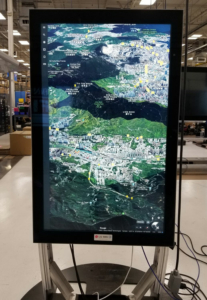 Manufacturing Resources International designs, engineers and fabricates BoldVu® LCD displays, maintaining the industry’s largest install base of outdoor LCDs with deployments in over 50 cities around the globe.
Manufacturing Resources International designs, engineers and fabricates BoldVu® LCD displays, maintaining the industry’s largest install base of outdoor LCDs with deployments in over 50 cities around the globe.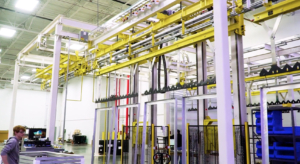 The system can handle parts up to twenty feet long by five feet wide by eight feet tall, and up to 800 pounds per loadbar.
The system can handle parts up to twenty feet long by five feet wide by eight feet tall, and up to 800 pounds per loadbar.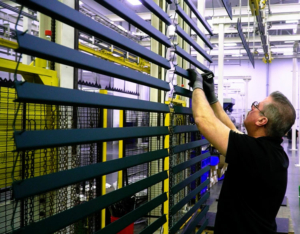 The addition of an IntelliFinishing system has brought a wide range of benefits to MRI’s operation, including:
The addition of an IntelliFinishing system has brought a wide range of benefits to MRI’s operation, including: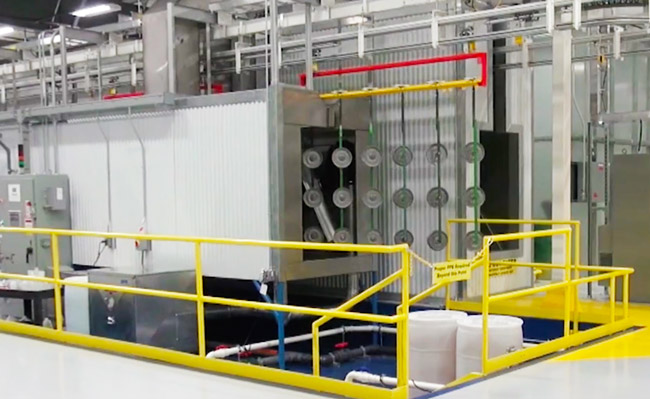 Wash recipes allow for different types of metals or parts with different pretreatment requirements to each have their own
Wash recipes allow for different types of metals or parts with different pretreatment requirements to each have their own 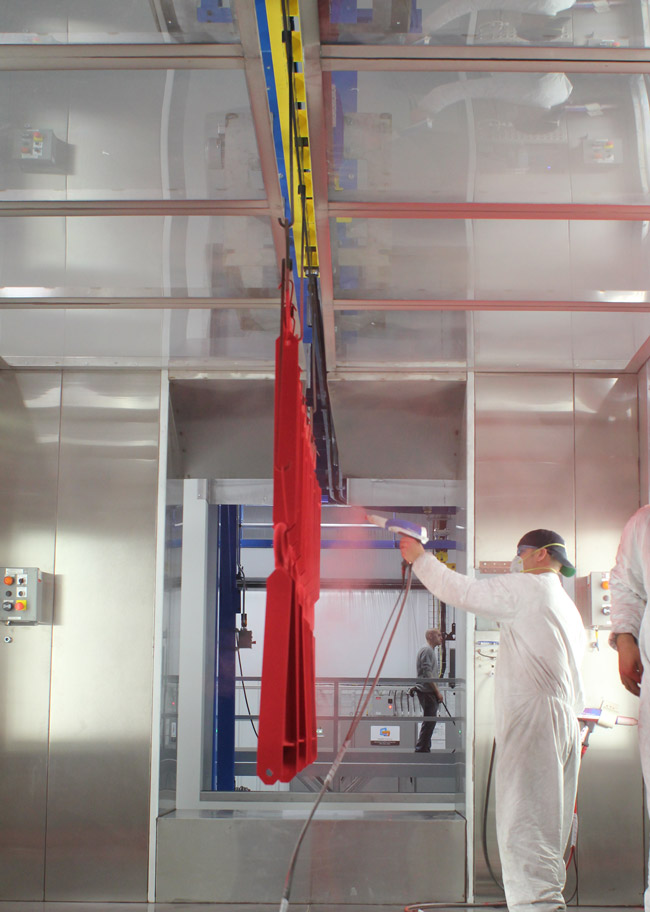
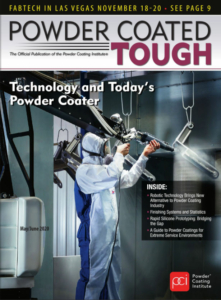
 Imagine your outsourcing of finishing has grown over the years to about $1 million per year with local (or maybe distant) custom-coaters. How much money could an automated, in-house system save you per year that would justify the relatively large capital expenditure?
Imagine your outsourcing of finishing has grown over the years to about $1 million per year with local (or maybe distant) custom-coaters. How much money could an automated, in-house system save you per year that would justify the relatively large capital expenditure? Depending on the types of product you need coated, even a relatively traditional monorail could be paid for in about two to four years for this amount of savings. After that, it would be savings that go to your bottom-line profits. Most simple monorail systems likely cost between $500,000 and $2,000,000, but this is entirely dependent on process requirements for pre-finish steps such as shot-blasting, washing, and dry-off ovens, as well as for the type of booths and cure ovens and specific conveyor requirements for the part dimensions and weight considerations.
Depending on the types of product you need coated, even a relatively traditional monorail could be paid for in about two to four years for this amount of savings. After that, it would be savings that go to your bottom-line profits. Most simple monorail systems likely cost between $500,000 and $2,000,000, but this is entirely dependent on process requirements for pre-finish steps such as shot-blasting, washing, and dry-off ovens, as well as for the type of booths and cure ovens and specific conveyor requirements for the part dimensions and weight considerations. Ultimately, this is just a first-cut calculation to begin the process of considering a new finishing system. If your calculus indicates you might benefit from a system, the next step is to start finding a vendor to draft up a layout and determine a budgetary or formal quote.
Ultimately, this is just a first-cut calculation to begin the process of considering a new finishing system. If your calculus indicates you might benefit from a system, the next step is to start finding a vendor to draft up a layout and determine a budgetary or formal quote. However, this dip in demand has us here at IntelliFinishing, along with our system partners, raring to go.
However, this dip in demand has us here at IntelliFinishing, along with our system partners, raring to go.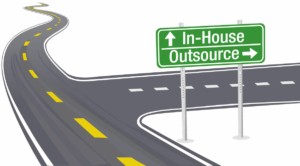 Of course, each situation is unique and would require in-depth analysis, but why not check into bringing your outsourcing in-house? (More on this topic in the coming weeks!) You’d also likely see far less rejects and defects, a reduction in transportation costs, faster turn times, less WIP, and better finish quality.
Of course, each situation is unique and would require in-depth analysis, but why not check into bringing your outsourcing in-house? (More on this topic in the coming weeks!) You’d also likely see far less rejects and defects, a reduction in transportation costs, faster turn times, less WIP, and better finish quality.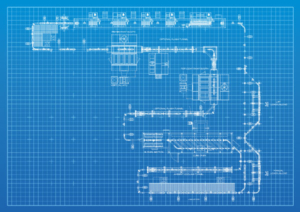 And, finally, if you have or are considering a system that consumes a larger facility footprint than an IntelliFinishing System can provide, you are missing an opportunity to use that space for other revenue producing activities or to have a smaller facility that costs less to build, own or lease.
And, finally, if you have or are considering a system that consumes a larger facility footprint than an IntelliFinishing System can provide, you are missing an opportunity to use that space for other revenue producing activities or to have a smaller facility that costs less to build, own or lease.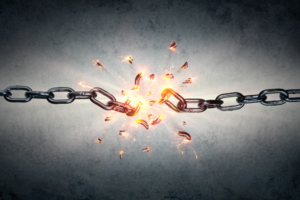 Traditional, chain-driven automated powder finishing systems are usually welded together and set to function at a certain line speed. Because of this, it’s difficult to expand the throughput and increase production. You could try to increase the line speed, but then you’d be increasing the speed of all the system processes. In most cases, that means disaster.
Traditional, chain-driven automated powder finishing systems are usually welded together and set to function at a certain line speed. Because of this, it’s difficult to expand the throughput and increase production. You could try to increase the line speed, but then you’d be increasing the speed of all the system processes. In most cases, that means disaster.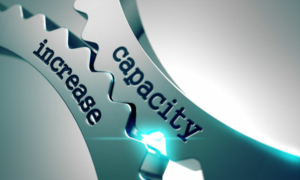 An IntelliFinishing automated finishing system is the perfect solution for having a modular, modifiable finishing system that can double its throughput.
An IntelliFinishing automated finishing system is the perfect solution for having a modular, modifiable finishing system that can double its throughput.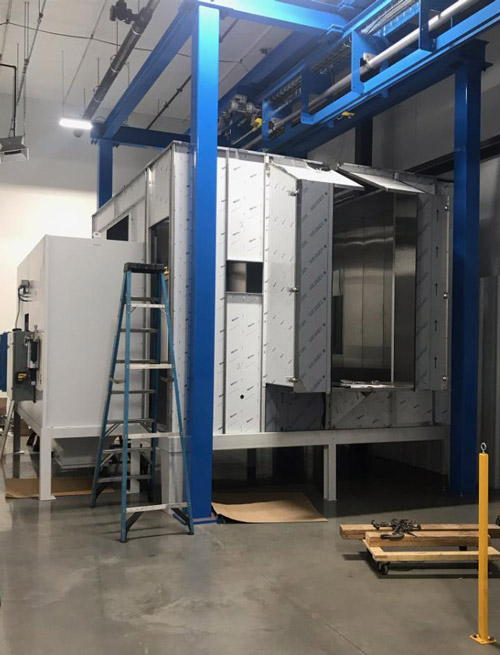 To address these needs, JR Custom chose to fit a new Parker Ionics Prime Coat booth into the company’s existing finishing system.
To address these needs, JR Custom chose to fit a new Parker Ionics Prime Coat booth into the company’s existing finishing system.
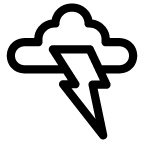 Weather
Weather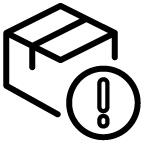 Equipment Purchases from Vendors Not on the Main System Contract
Equipment Purchases from Vendors Not on the Main System Contract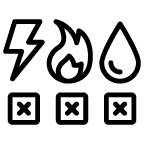 Local Licenses and Utilities
Local Licenses and Utilities 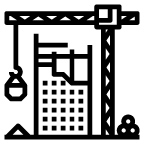 Building Site Construction Delays
Building Site Construction Delays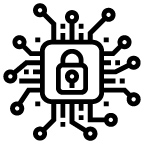 Really Unexpected Situations
Really Unexpected Situations